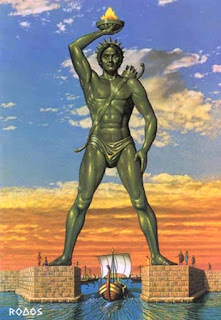 |
| FAIL! No straddling! |
OK. Let's get one thing straight.
The Colossus of Rhodes DID NOT STRADDLE THE HARBOUR.
Fun though that might have been: sailing underneath and looking up as you entered the harbour. He probably stood in a sanctuary on a hill behind Rhodes Town where he could have been seen for miles.
Before I tell you some TRUE facts, let me correct some common misconceptions about Rhodes and the Colossus. (BTW, Colossus just means a "colossal" or "massive" figure.)
[They didn't have the technology]
2. He did NOT wear nappies/tunic.
[He would have been nude]
3. He was NOT based on Statue of Liberty.
[It was based on HIM!]
4. He is NOT still standing today.
[He was toppled, & later chopped up for scrap & carried away]
5. He did NOT have a big old beard.
[unlike this early cover version (left) for The Colossus of Rhodes]
 |
| FAIL! (too small) |
I. It represented the Sun god (fuit Solis colossus)
II. It was built c. 292 BC by the sculptor Chares of Lindus
III. It probably had spikes on its head, representing rays of the sun.
IV. It was 105 feet high (LXX cubitorum altitudinis)
[The Statue of Liberty from her heels to the top of her head is 111 feet high. ]
V. It only stood for 66 years...
VI. ...then was toppled by an earthquake.
VII. Even in chunks on the ground it was considered one of the 'Seven Sights'
VIII. Few people were tall enough to circle the thumb with both arms. [Did you know your arms outstretched roughly equals your height?]
IX. People could walk around inside the hollow parts on the ground.
X. There were hundreds of other colossi in Rhodes Town, the capital city of the island.
XI. There was a colossal statue in Rome based on this statue of the sun. [It was originally a statue of Nero but after his death the head was changed!]
XII. The Flavian Amphitheatre was called the Colosseum after the Roman Colossus nearby.
 |
| YAY! Ben Lloyd-Hughes is "Floppy" |
I. It was a base of slave trading in Roman times
2. It had a population of small deer...
3. ...imported upon the advice of an oracle...
4. ...to rid Rhodes of an infestation of snakes!
5. A Greek poet called Apollonius came from Rhodes
6. He wrote an epic poem about Jason called the Argonautica
7. The walking bronze giant Talus in this poem might be based on the colossus in the Argonautica
8. In the 1st century AD a young Roman began to write his own Argonautica in Latin verse
9. His name was Gaius Valerius Flaccus (Flaccus means "Floppy")
10. He appears in the Roman Mysteries TV series and books
You can enjoy an exciting mystery involving a trip to Rhodes, the slave-trade and a thrilling fight atop the Colossus if you read The Colossus of Rhodes or watch season 2 of the Roman Mysteries TV series.
 |
| Marco Polo Mansion in Old Rhodes Town, where I stayed during my 2003 research trip |
[Roman Mystery 9 - The Colossus of Rhodes - and Roman Mystery 10 - The Fugitive from Corinth - are perfect for children aged 9+, especially those studying Greeks as a topic in Key Stage 2. The glossy BBC Roman Mysteries TV series did adaptations of both these books.]
Read a Classicist's review of The Colossus of Rhodes book/TV and The Fugitive from Corinth TV episode.

No comments:
Post a Comment